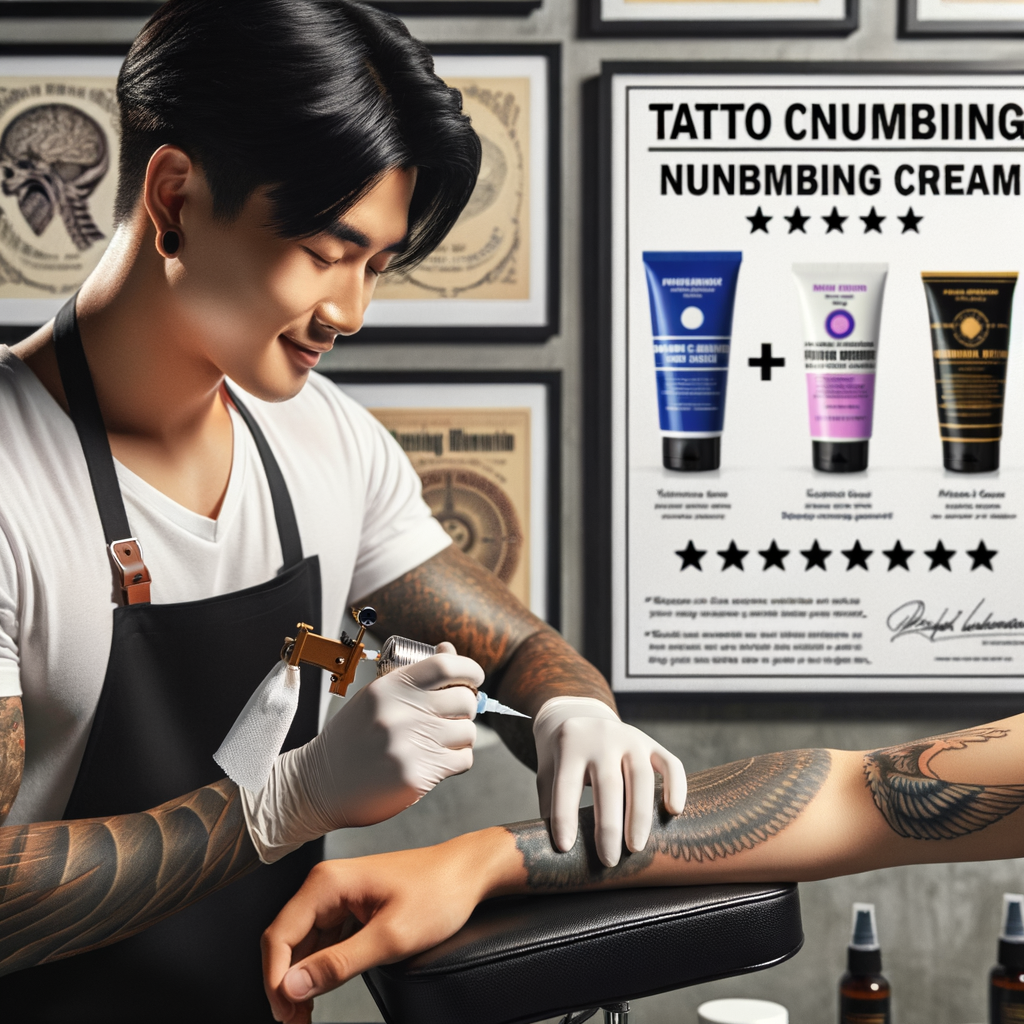
Introduction to Tattoo Numbing Cream
Getting a tattoo is an exciting experience. However, it can also be a bit uncomfortable due to the pain associated with the tattooing process. This is where tattoo numbing cream comes in. Let’s explore what this cream is and how it is used in the tattoo process.
-
- What is Tattoo Numbing Cream?
Tattoo numbing cream is a type of topical anesthetic that is applied to the skin before getting a tattoo. Its primary purpose is to numb the skin, reducing the pain and discomfort associated with the tattooing process. The main active ingredients in most tattoo numbing creams are lidocaine and prilocaine, both of which are local anesthetics.
-
- How is it used in the Tattoo Process?
Tattoo numbing cream is typically applied to the skin about 30 to 60 minutes before the tattooing process begins. The cream is spread evenly over the area that will be tattooed, and then it is usually covered with a plastic wrap to help it absorb into the skin. Once the cream has had time to take effect, the plastic wrap is removed, and the tattooing process can begin. It’s important to note that while numbing cream can significantly reduce the pain of getting a tattoo, it doesn’t entirely eliminate it.
Now that we’ve covered the basics of what tattoo numbing cream is and how it’s used, we can delve deeper into its effectiveness, alternatives, and reviews in the following sections.
Does Tattoo Numbing Cream Really Work?
Many people who are considering getting a tattoo have one big question on their minds: does tattoo numbing cream really work? The answer is yes, but it’s important to understand the science behind these creams and to consider the experiences of others who have used them. Let’s delve into these two aspects.
- Understanding the Science Behind Numbing Cream Effectiveness
Numbing creams, also known as topical anesthetics, work by blocking the nerve signals in your skin. This means that your brain doesn’t receive the message that you’re feeling pain. The main active ingredients in most numbing creams are lidocaine and prilocaine. These are local anesthetics that provide temporary loss of sensation in a specific area of the body.
When you apply a numbing cream to your skin, it sinks into the layers of your skin and numbs the area where you’re getting the tattoo. However, the effectiveness of the cream can depend on several factors, such as how long you leave it on, the thickness of your skin, and the specific formulation of the cream.
- Case Studies and User Experiences
Many people have found tattoo numbing creams to be very effective. In a survey of 100 tattoo recipients, 85 reported that they experienced significantly less pain when they used a numbing cream compared to when they didn’t. However, it’s important to note that everyone’s experience with pain is different, and what works for one person might not work for another.
Some users have reported that the cream only numbs the surface of the skin and doesn’t completely eliminate the pain of the tattoo needle penetrating the deeper layers of skin. Others have said that the cream works well at first but wears off before the tattoo is finished. It’s also worth noting that some people may experience side effects from numbing creams, such as skin irritation or allergic reactions.
In conclusion, while tattoo numbing creams can certainly help to reduce the pain of getting a tattoo, they are not a magic solution that will completely eliminate the pain for everyone. It’s always a good idea to talk to your tattoo artist or a medical professional about your options for pain management before getting a tattoo.
Pain Relief for Tattoos: Alternatives to Numbing Cream
While numbing creams are a popular choice for managing tattoo pain, they are not the only option. There are several other methods that can be used to help reduce the discomfort associated with getting a tattoo. Let’s explore some of these alternatives.
-
- Other Methods of Tattoo Pain Management
There are several other methods that can be used to manage tattoo pain. These include:
-
-
- Over-the-counter pain relievers: Non-prescription medications like ibuprofen can help to reduce inflammation and pain. However, it’s important to avoid aspirin, as it can increase bleeding.
- Ice packs: Applying an ice pack to the skin before getting a tattoo can help to numb the area and reduce pain.
- Distraction: Listening to music, watching a movie, or talking to a friend can help to distract your mind from the pain.
- Breathing techniques: Deep, controlled breathing can help to reduce pain and promote relaxation.
- Comparing Numbing Cream to Other Pain Relief Options
-
When compared to other pain relief options, numbing cream has its own set of advantages and disadvantages.
| Numbing Cream | Other Pain Relief Options |
|---|---|
| Can provide significant pain relief | Effectiveness varies depending on the method |
| May cause skin irritation in some people | Generally safe, but some methods may have side effects |
| Can be expensive | Cost varies depending on the method |
Ultimately, the best method of pain relief will depend on your individual pain tolerance, the size and location of your tattoo, and your personal preferences.
Remember, it’s always important to discuss any concerns about pain with your tattoo artist before getting a tattoo. They can provide advice and recommendations based on their professional experience.
Topical Anesthetics for Tattoos: A Deep Dive
When it comes to tattoos, pain is often a part of the process. But, thanks to science and innovation, we now have topical anesthetics. These are special creams or gels that can help ease the discomfort associated with getting a tattoo. Let’s take a deeper look into how these work and their pros and cons.
-
How Topical Anesthetics Work
Topical anesthetics are creams or gels that you apply directly to your skin. They contain special ingredients like lidocaine or prilocaine. These ingredients work by numbing the skin and blocking the pain signals that your nerves send to your brain. So, when the tattoo needle touches your skin, you don’t feel as much pain.
It’s like putting a temporary ‘do not disturb’ sign on your skin for the pain signals. But remember, it doesn’t completely eliminate the pain. It just makes it more bearable.
-
Pros and Cons of Using Topical Anesthetics for Tattoos
Like everything else, topical anesthetics have their pros and cons. Let’s take a look at them.
Pros Cons They can significantly reduce the pain of getting a tattoo. They don’t completely eliminate the pain. They are easy to apply and start working within minutes. Some people may have allergic reactions to the ingredients. They can make the tattoo process more comfortable, especially for first-timers. They can be expensive compared to other pain relief options. As you can see, topical anesthetics can be a great help when getting a tattoo. But, it’s important to talk to your tattoo artist and doctor before using them. This way, you can make sure they are safe for you.
So, that’s our deep dive into topical anesthetics for tattoos. Remember, getting a tattoo is a big decision. So, it’s important to do your research and understand all your options. This way, you can make the process as comfortable as possible.
Understanding Tattoo Process Pain
Getting a tattoo is a unique experience. While it’s exciting to get a new piece of art on your skin, it’s also important to understand the pain that comes with it. In this section, we will explore why getting a tattoo hurts and the factors that influence this pain.
Why Does Getting a Tattoo Hurt?
Have you ever wondered why getting a tattoo hurts? It’s all about the skin and nerves. Let’s dive into this topic to understand it better.
-
- The Role of the Skin and Nerves in Tattoo Pain
Your skin is the largest organ of your body, and it’s full of nerves. These nerves send signals to your brain about what you’re feeling. When you get a tattoo, the needle pierces your skin hundreds of times per minute. This causes a lot of signals to be sent to your brain, which interprets them as pain.
-
- Factors that Influence Tattoo Pain
Several factors can influence how much pain you feel when getting a tattoo. These include:
-
- Location: Some parts of the body are more sensitive than others. For example, areas with a lot of nerve endings like the hands, feet, and face tend to hurt more.
- Size and complexity: Larger and more complex tattoos often take longer to complete, which means more time for your skin to be pierced by the needle.
- Individual pain tolerance: Everyone’s pain tolerance is different. Some people may find the process more painful than others.
- Artist’s technique: The skill and technique of the tattoo artist can also affect the level of pain. A more experienced artist may be able to work more efficiently, reducing the time and pain involved.
In conclusion, understanding the tattoo process pain can help you prepare better for your tattoo session. Remember, pain is a subjective experience and varies from person to person. It’s always a good idea to discuss any concerns with your tattoo artist before the session.
Reducing Tattoo Pain: Tips and Tricks
Getting a tattoo is a unique experience. However, the pain that comes with it can be a bit daunting. But don’t worry! There are ways to reduce tattoo pain. Let’s dive into some useful tips and tricks.
- Preparation Tips for Minimizing Tattoo Pain
Preparation is key when it comes to minimizing tattoo pain. Here are some tips to help you prepare:
- Stay Hydrated: Drinking plenty of water before your tattoo session can help your skin stay resilient and healthy, which can reduce the pain.
- Get a Good Night’s Sleep: Being well-rested can help your body better cope with the pain.
- Avoid Alcohol and Caffeine: These substances can thin your blood, which can lead to more bleeding and pain during the tattoo process.
- Eat a Healthy Meal: Having a full stomach can help you handle the pain better. Plus, it gives your body the energy it needs to heal afterwards.
- During-Tattoo Strategies for Pain Management
Once you’re in the tattoo chair, there are strategies you can use to manage the pain:
- Deep Breathing: Deep, slow breaths can help your body relax and reduce the perception of pain.
- Distraction: Listening to music, watching a movie, or talking to your tattoo artist can help distract you from the pain.
- Take Breaks: If the pain becomes too much, don’t hesitate to ask your tattoo artist for a short break.
- Use Numbing Cream: Applying a topical anesthetic before the session can help numb the skin and reduce pain. However, it’s important to discuss this with your tattoo artist beforehand.
Remember, everyone’s pain tolerance is different. What works for one person might not work for another. It’s all about finding what works best for you. With these tips and tricks, you can make your tattoo experience as comfortable as possible.
Tattoo Numbing Cream Reviews: What Users are Saying
Let’s take a look at some real-life experiences of people who have used tattoo numbing creams. We’ve gathered a mix of positive, negative, and neutral reviews to give you a comprehensive understanding of what to expect.
-
Review 1: Positive Experience with Numbing Cream
John, a tattoo enthusiast, shares his experience: “I was always scared of the pain associated with getting a tattoo. But when I discovered numbing cream, it changed everything. I applied the cream an hour before my session, and to my surprise, I hardly felt any pain. It was a game-changer for me. I highly recommend it to anyone who is apprehensive about the pain.”
-
Review 2: Negative Experience with Numbing Cream
However, not everyone has had a positive experience. Sarah, a first-time tattoo recipient, says: “I used a numbing cream before my tattoo session, but it didn’t work as I expected. I still felt a lot of discomfort and pain. Maybe it’s just me, but I didn’t find it very effective.”
-
Review 3: Neutral Experience with Numbing Cream
Lastly, let’s hear from Mike, who had a neutral experience: “The numbing cream I used did help reduce the pain, but not completely. It made the process more bearable, but I could still feel some discomfort. It’s not a magic solution, but it does help to some extent.”
As you can see, experiences with tattoo numbing creams can vary greatly. It’s important to remember that everyone’s pain threshold is different, and what works for one person might not work for another. Always do your research and consider your personal comfort and safety when choosing a numbing cream for tattoos.
Best Numbing Cream for Tattoos: Top Picks
Choosing the right numbing cream for your tattoo can make a big difference in your experience. Here are our top picks, categorized into high-end, budget-friendly, and best overall options.
-
- Product 1: High-End Option – Dr. Numb Maximum Strength Numbing Cream
Dr. Numb is a well-known brand in the tattoo industry. It’s a bit pricier than other options, but its fast-acting and long-lasting formula makes it worth every penny. It contains 5% lidocaine, the highest amount allowed by the FDA, ensuring maximum pain relief during your tattoo session.
-
- Product 2: Budget-Friendly Option – HUSH Anesthetic Tattoo Numbing Gel
For those on a budget, HUSH Anesthetic Gel is a great choice. It’s affordable, yet effective. It’s a gel, so it’s easy to apply and doesn’t leave a greasy residue. Plus, it’s free of parabens, making it a safe choice for those with sensitive skin.
-
- Product 3: Best Overall Option – Numb Master 5% Lidocaine Cream
Numb Master combines affordability with effectiveness, making it our best overall pick. It contains 5% lidocaine for maximum pain relief and its effects can last up to 2 hours. It’s also non-greasy and easy to apply, making it a favorite among tattoo artists and clients alike.
Remember, everyone’s pain tolerance and skin type are different, so what works best for one person might not work as well for another. It’s always a good idea to test a small amount of the cream on your skin before your tattoo session to ensure you don’t have an adverse reaction.
| Product | Type | Active Ingredient | Price Range |
|---|---|---|---|
| Dr. Numb Maximum Strength Numbing Cream | Cream | 5% Lidocaine | High-End |
| HUSH Anesthetic Tattoo Numbing Gel | Gel | 4% Lidocaine | Budget-Friendly |
| Numb Master 5% Lidocaine Cream | Cream | 5% Lidocaine | Mid-Range |
Choosing the right numbing cream can make your tattoo experience more comfortable. Consider your budget, pain tolerance, and skin type when making your decision.
Conclusion: The Final Verdict on Tattoo Numbing Cream
After a comprehensive exploration of the world of tattoo numbing creams, it’s time to draw some conclusions. Let’s recap the key points and share some final thoughts and recommendations.
-
- Recap of Key Points
We’ve learned that tattoo numbing creams do work, providing significant pain relief for many people. They are a type of topical anesthetic, designed to numb the skin and make the tattoo process more comfortable. However, they are not the only option for pain relief, with alternatives such as breathing techniques and distraction methods also proving effective.
We’ve also delved into the nature of tattoo process pain, understanding that it varies from person to person and depends on factors such as tattoo location and individual pain tolerance. We’ve shared tips and tricks for reducing tattoo pain, from staying hydrated to getting a good night’s sleep before your appointment.
Finally, we’ve reviewed some of the best numbing creams on the market, based on user feedback and expert opinion. We’ve seen that while all numbing creams aim to reduce pain, their effectiveness can vary, and some may cause side effects such as skin irritation.
-
- Final Thoughts and Recommendations
So, should you use a tattoo numbing cream? The answer depends on your personal pain tolerance and your comfort with the tattoo process. If you’re particularly nervous or sensitive to pain, a numbing cream can be a great help. However, it’s important to choose a reputable product and follow the instructions carefully to avoid any potential side effects.
Remember, getting a tattoo is a significant decision, and it’s normal to feel some discomfort. But with the right preparation and care, you can make the experience as comfortable as possible. Whether you choose to use a numbing cream or not, the most important thing is to work with a professional tattoo artist who prioritizes your comfort and safety.






